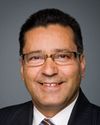Thank you, Mr. Chairman and honourable members. My name is Joan Atlin and I'm the director of programs for the Toronto Region Immigrant Employment Council, or TRIEC.
TRIEC is a multi-stakerholder council that brings together employers, community organizations, colleges, universities, occupational regulatory bodies, and all three orders of government to seek practical solutions to connect skilled immigrants with appropriate employment.
At TRIEC our understanding of foreign credential recognition is cast broadly. In an effort to maximize our reach and impact, we have focused on those highly skilled immigrants who are seeking employment in non-regulated professions, which actually represents the majority of immigrants to Canada. They are people like sales managers, financial analysts, software developers, project managers, HR professionals, etc. Whether and how their credentials, experience, and qualifications are recognized is up to the employer. So our work with regard to foreign credential recognition has been focused largely on reaching out to employers to build their capacity to recognize immigrants' skills, experience, and qualifications.
For many employers, concerns about hiring skilled immigrants include not understanding their experience, not being familiar with their credentials or previous employers, and concerns about communication skills. Often the requirement for Canadian experience, which we hear so much about, is in fact a kind of euphemism for not knowing how to interpret the immigrant's qualifications.
This lack of familiarity, and the perceived risk that goes along with it, leads to widespread non-recognition of qualifications by employers in non-regulated professions. This has been our focus since TRIEC was established in 2003. We think it's important to recognize that some programs, initiatives, and practices have met with success and that future directions should build on this success. So the remainder of my comments will focus on the opportunities we think the federal government should consider in order to facilitate immigrant attachment to the workforce and opportunities delivered by third-party organizations.
The first is internships, or work-experience programs. They have been successful employment interventions because they directly connect employers and skilled immigrants. Internships can provide immigrants with their flrst job in Canada as well as professional references, both of which reassure risk-averse employers. On average, about 80% of participants find full-time work in their field upon completion of a work-experience program—a highly successful outcome, both for the individual and for the economy.
However, the demand for internships from immigrants far exceeds the number of participating employers and positions. There are also employers and communities across the country that would welcome an internship program but lack the capacity to establish one. There is a need for a national internship program that could leverage the participation of employers across the country.
The federal government has the opportunity to set an example as an employer by taking the lead in offering targeted internships for skilled immigrants. In 2010, the federal internship for newcomers program was established. The program was initially piloted by CIC and HRSDC and has now expanded to a number of other departments. According to the government's 2010 annual report on foreign credential recognition, there were 65 internships offered through the program in 2010.
There's considerable scope to expand this program across the federal government. The Ontario Public Service has a similar internship program that has placed nearly 600 newcomers in internships between 2006 and 2011 in Ontario alone.
The second intervention I want to talk about is mentoring programs. They have been successful because they connect skilled immigrants with a mentor who is an established colleague in their occupation. The mentor shares professional networks and helps navigate the job search. The mentee, a skilled immigrant job-seeker, gains a greater understanding of the occupational context and expectations in Canada.
In 2004, TRIEC launched our mentoring partnership. To date, more than 6,000 immigrants in the greater Toronto area have been matched through this program and 70% of them are employed in their field or a related one within six months after the end of their mentoring relationship. While many smaller-scale mentoring programs are currently offered across the country, they often have difficulty recruiting mentors and they lack the marketing resources they need to build a profile for their programs.
CIC is currently supporting ALLIES, which is a national project of the Maytree and McConnell foundations, to share this mentoring model nationally. ALLIES is building on the experience of TRIEC to support other immigrant employment councils across the country. Together, we have provided advice and supported the start-up of similar mentoring initiatives in Halifax, Montreal, Calgary, and Edmonton. There's a strong role for the federal government to play as an employer-partner in these local mentoring initiatives.
TRIEC is currently working with the Foreign Credentials Referral Office, the FCRO, to launch a mentoring pilot in the Ontario region of CIC. Pilots will also be launched with our sister employment councils in Calgary and Ottawa. This pilot should pave the way to national involvement of the federal public service in mentoring programs for skilled immigrants. However, beyond the role of supporting the dissemination of the model and participating as an employer, there is a need for a funded national mentoring program to ensure the ongoing delivery of this successful intervention. Creating a national mentoring program would allow for enhanced program quality and coordination, increased employer participation, and reliable and sustained funding for these programs.
Third, I will talk about bridging programs, which you heard quite a bit about with the previous panels. They were initially piloted in regulated professions. They bring together key stakeholders—employers, occupational regulatory bodies, and educational institutions—to assess immigrant skills and competencies, deliver training to fill gaps, and provide mentoring and workplace or required clinical experience. The objective of these programs is to fill gaps that may exist in knowledge or skills while avoiding duplication in the immigrants' education and training so that they can be bridged quickly to licensure and/or employment in their fields. To date, there are many successful examples of bridging programs in various sectors, both regulated and non-regulated sectors. Most bridging programs have been funded by provincial ministries and while the outcomes of the bridging programs have been very promising, they are only accessible to a limited number of participants and are difficult to sustain. The FCRO is currently developing a website called the International Qualifications Network as a vehicle to disseminate best practices on bridging programs and other initiatives. Beyond this promising initiative, there may be an opportunity for the federal government to invest in a nationally-coordinated bridge-training strategy as well as to create a loan program for participants to cover their living costs. You heard about that from the previous panel as well.
The fourth element I want to talk about is employer engagement, which is key to immigrant employment success. While there has been a significant investment in the development of labour market programs for immigrants, there has not yet been a parallel investment in programs targeted directly at employers. Ultimately, it's employers who either recognize or reject the credentials of skilled immigrants. We and our immigrant employment council partners across the country have seen a strong and growing demand from employers for support in recruiting, assessing, integrating, and promoting skilled immigrants, and we need a national strategy to respond to this demand. Of the three key elements of employer engagement needing support, the first is awareness.
There is still a need to increase employer awareness of the value of immigrant skills, and of how including this talent pool can make Canada more productive and competitive in the global marketplace. Despite an uncertain economic outlook, the evidence is unequivocal that immigrant skills will play a key role in the Canadian labour force in the upcoming years. With support from CIC and HRSDC's FCR program, TRIEC has been successful in running awareness campaigns to engage employers, and an employer awards program to recognize innovative and leading employer practices.
Second, employers need tools and resources to support organizational change. There's a wide array of assessment tools for language, for credentials, for competencies, and HR practices that employers need to learn about and be able to implement. Hireimmigrants.ca, a website originally developed by TRIEC and now managed by the national ALLIES project, is a key national resource for employers. It houses a wealth of resources for employers, including best practices and case studies from around the country. There is an opportunity for the federal government to fully endorse hireimmigrants.ca as the go-to place for employers and to support extensive marketing for this resource.











